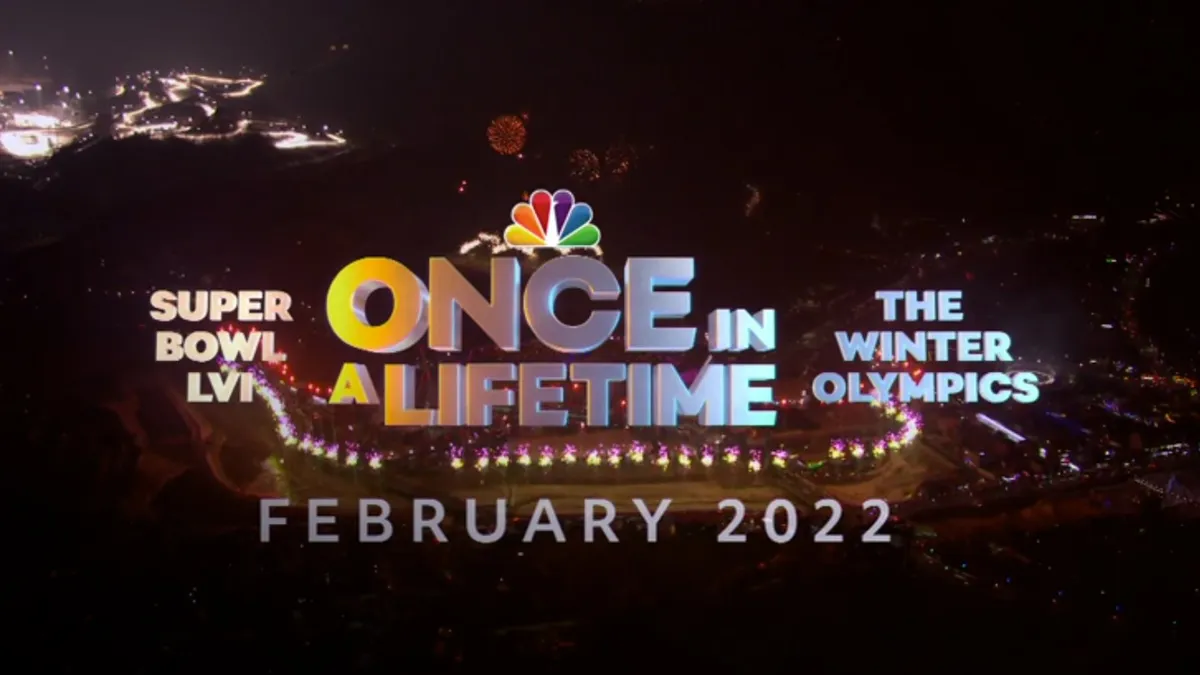NBCUniversal has ramped up its efforts to usher in a new era of measurement as the advertising industry grapples with an increasingly fragmented video landscape and challenges to the dominance of Nielsen, which has struggled to adapt to the streaming age. The media conglomerate this month faced its first major test of its new approach to cross-platform measurement as both the Super Bowl and Winter Olympics aired across its linear, streaming and digital channels.
NBCU positioned the simultaneous Super Bowl-Olympics push — including what it dubbed "Super Gold Sunday," the first time the two events overlapped — as the first chance to show off its partnership with iSpot.tv, which it named as a preferred measurement partner in January.
During the Super Bowl — the most-watched show in five years — the average ad reached 106 million viewers, per iSpot metrics, with the big game generating more than 4 billion verified household ad impressions across platforms. The advertisers that ponied up for a spot were rewarded: The 81 national ads accounted for more than 40% of all TV ad impressions on linear TV on game night.
And while Olympics ratings were down — as expected — the event averaged 1 billion ad impressions per day, with the NBC Olympics primetime Winter Games presentation maintaining a 22% lighter ad load and delivering 262% more ad impressions per unit than the other three broadcast networks combined, per iSpot. NBCU is trumpeting iSpot's metrics to highlight both the Super Bowl and the Olympics as wins for advertisers.
"We always say that advertisers don't buy ratings, they buy results, and they're buying the value of the game," said Kelly Abcarian, NBCU's executive vice president of measurement and impact. "With this type of measurement, we can directly show them the impact it has on their brand and on their business, and then that leads us on a path to really connecting that measurement directly to outcomes."
Abcarian, who joined NBCU in 2021 after nearly 16 years at Nielsen, and iSpot.tv CEO Sean Muller spoke to Marketing Dive about what the partnership means for advertisers and measurement, as the network prepares for its upfront presentation in May.
The interview has been edited for clarity and brevity.
MARKETING DIVE: With the Super Bowl and Winter Olympics behind you, what were the major takeaways of the NBCU-iSpot partnership?
KELLY ABCARIAN: We are seeing the power of measuring the ads for the first time. This is the first Olympics where our advertisers could directly see and understand the ad delivery across linear, streaming and digital. And for the Super Bowl, obviously, it's all about the ads. It was super exciting to be able to not only measure the ads on the big glass, but to truly do that across platforms [and] truly understand that complete consumer.
For every single game, we're getting a reminder that every second matters, and that's exactly what this measurement is doing. For us, it's allowing us to bring that understanding straight back to our advertisers, and this is giving them that complete picture of the ad performance. It's fast: We're able to do this on a 48-hour rolling lag basis in terms of the ad delivery, and we've been able to look at content understanding on a next day basis, across all screens.
When you think about the types of insights our advertisers are able to glean, it's the first time where they're able to see meaningful metrics about their business that help them understand ad loads [and] ad metrics that help them understand the attention, impact and completion rates.
SEAN MULLER: We have a single-source measurement for both linear and the streaming environments, and then can understand not just the audience delivery across both of those things, which of course, is super important, but understand the behavior of these households and who's consuming it on streaming versus linear.
For the Super Bowl, 70% of households that were streaming the game were not paid TV households. In the Olympics, we're seeing 65% of streaming households are only streaming the Olympics, whereas the other 35% are streaming and watching it on linear. So it's really [about] understanding that de-duplication of audience across screens. It's really shining a light on the ads and not just the program ratings, and starting to understand the value not just to advertisers, but to consumers as well.
"We always say that advertisers don't buy ratings, they buy results, and they're buying the value of the game."

Kelly Abcarian
Executive vice president, measurement and impact, NBCUniversal
In addition to the audience numbers, we looked at ad loads. The Olympics had significantly lower ad loads than other programming that was going on. We know they had a much higher audience, too, and then we were looking at their completion rates. In other words, our consumers are staying tuned to the ads during the programming, which is generally indicative of high-quality content. So all of a sudden, the advertisers really understand the environment they're in and the value they're receiving beyond just the program ratings.
How have advertisers responded to the new measurement metrics?
ABCARIAN: The fact that they're getting ad delivery pretty much next next day in an event like the Olympics that runs across 17 days, where every second can matter … I think they're seeing the power of this platform for sharing the power of measurement.
We know our advertisers want to be part of the Olympics, not just to support the athletes, but they want to understand the impact across all of the touch points where we distributed the Olympics. ISpot and their team helped us to measure over 20 different touch points that sit outside of the linear lineup, which is critical, because it's not about whether it's live: The medal wasn't worth any less and neither is the moment. The advertisers really want to know that true consumer receptivity and engagement to their advertising when it occurs and when the consumer chooses to consume it.
Our advertisers are enjoying record high engagement… when you put on great content, consumers stay and stay engaged in the ad spots themselves. Because of the lighter ad load, they're benefiting from a less cluttered environment in which to really connect uniquely with that consumer. I expect to hear a lot of excitement around how this is really ushering in a new measurement era where you can really see the power of how every second truly matters.
What does this first test mean for the future of measurement?
ABCARIAN: We all know change is coming. Even our legacy currency itself is changing. It's imperative that we all take a step back and evaluate the options on how we bring better measurement forward.
We did a very deep evaluation through our RFP process. Our focus was really around bringing full transparency to that process. We scored the alternative currency providers across more than 25 different variables or attributes, and we made that public as to exactly how we felt the alternative currencies are.
"Nielsen One is slated to come out to 2024, but our consumer is not waiting."

Kelly Abcarian
Executive vice president, measurement and impact, NBCUniversal
There are multiple currency contenders ready to help us solve the problem with cross-platform measurement. Nielsen One is slated to come out to 2024, but our consumer is not waiting. So it's an imperative that we connect the streaming and digital measurement back to the linear measurement, the way that it should have always been connected, so that our advertisers can get a complete picture to see it all, count it all and value it all.
When you measure using the scale of census-like data inputs across linear and streaming, you really are able to see many more impressions. On average, we've seen more impressions and more reach, and it isn't just on streaming, it's across linear alike. Because you're moving away from a small panel to scaled data sets in this fragmented world, it is imperative to drive better accuracy, reliability and consistency of the audience estimates that we need to transact billions of dollars against.
What are the next steps for NBC and other media companies to finally solve the measurement problem?
ABCARIAN: We've been incredibly transparent on everything we are doing so we can all move faster and establish a measurement era based on advertising to help our buyers really get the measurement they deserve. As part of that, we have included the industry trade bodies like the ANA and the VAB into our Measurement Innovation Forum so we could bring forth the education and transparency around what we're doing, because we know creating better measurement for advertisers is an imperative as we move ahead.
We wanted to make sure as a first step that all of our efforts focus on servicing the advertisers, as we believe that measurement is not only a team sport, but total coordination between buyers and sellers is key. That's why we've kicked off this massive test-and-learn. We have over 60 advertisers locked in to participate with us, which just shows you the excitement the industry at large has in bringing forward better measurement for the future and not waiting two to three years down the road.























